People
‘We Had Every Meal Together’: Artist Vivian Suter on the Close Artistic Collaboration She Forged With Her Late Mother
Suter and her mother, the recently deceased artist Elisabeth Wild, both opened shows in Europe this month.
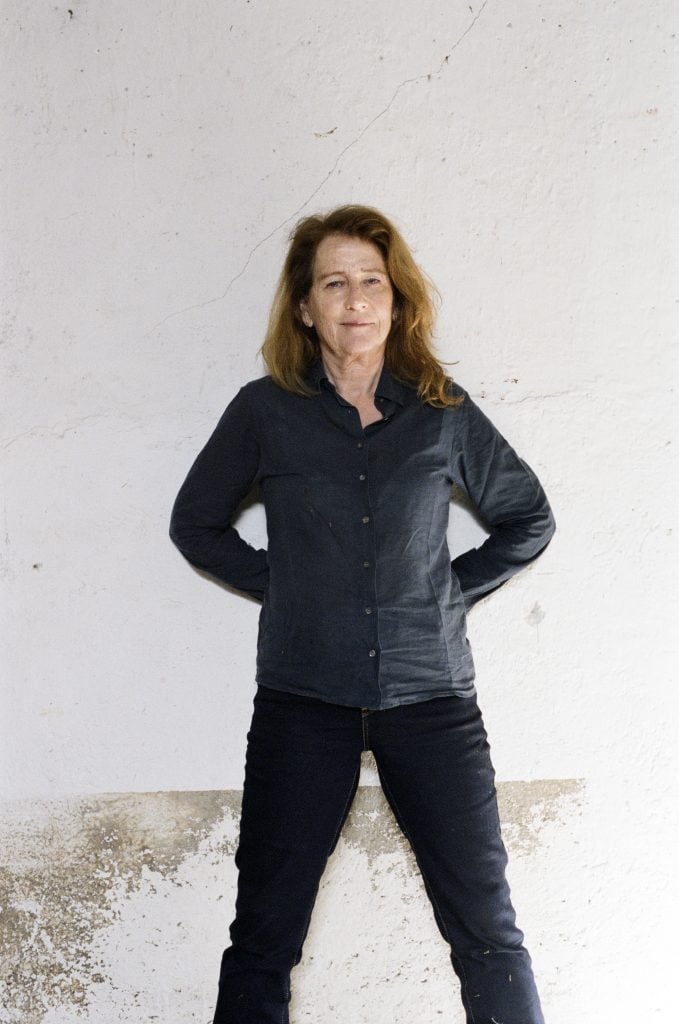
Suter and her mother, the recently deceased artist Elisabeth Wild, both opened shows in Europe this month.

Kate Brown

Vivian Suter has not left the house in a long while.
Shortly after the artist answered my phone call from her outdoor studio in rural Guatemala, another phone rang. Her dogs, Bonzo, Tintin, and Nina, were howling. She paused to answer the other call and, coming back onto the line with me, she let out a sigh: she had just canceled her first outing in months.
“I had this phone call with you as a good excuse,” she said, laughing.
The Swiss-Argentinian painter has been living and working largely in solitude on her lush property, a former coffee plantation, for the past seven months, and not only because of widespread closures and restrictions. She has also been in mourning. Her mother, the artist Elisabeth Wild, died a month before the world went into lockdown, just six days after her 98th birthday.
“I feel lonesome,” Suter told Artnet News. “I almost lived at her house. We had every meal together.”
The two began showing together in major exhibitions in recent years, at the Power Plant in Toronto, Karma International in Zürich, and at Documenta 14. Wild, in fact, first came to international prominence when she was included in Suter’s mid-career survey at Kunsthalle Basel in 2014.
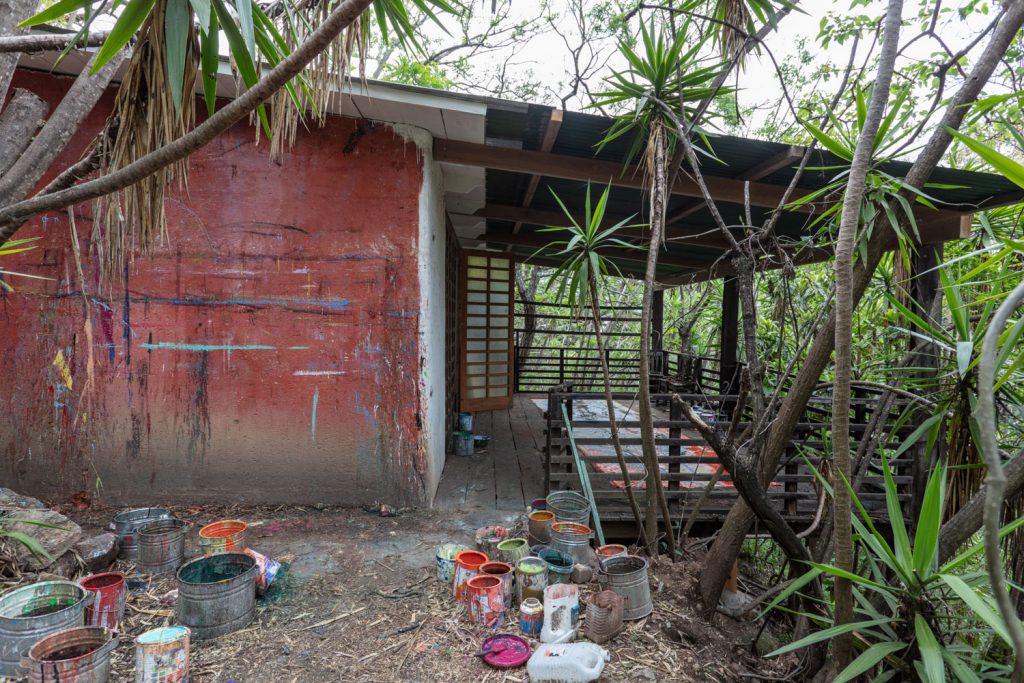
Vivian Suter’s studio in Guatemala, 2018. Courtesy of the Artist und Gladstone Gallery, New York/Brüssel; House of Gaga; Karma International und Proyectos Ultravioleta. Foto: David Regen.
One of their most recent collaborative exhibitions opened in Berlin at the Brücke Museum this month. Titled “Bonzo’s Dream,” the show is remarkable for being one of the first in which contemporary artists are being shown alongside the institution’s formidable collection of Die Brücke artists. The seminal Expressionist art group, formed in 1905 in Dresden, included artists such as Emil Nolde and Ernst Ludwig Kirchner, and helped catapult Modern art into the 20th century.
What’s more, it is Suter’s first museum show in Germany, and just across the Alps, Wild is having her first solo exhibition in Europe, at Karma International. Both are the last exhibitions Wild worked on before she died.

Elisabeth Wild’s show at Karma International. Photo: Annik Wetter.
Of course, Suter is not totally alone. There is an 18-year-old man named Antonio who lives on her property with Suter and helps the 70-year-old artist move her paintings around, sometimes offering his two cents about the colors in her pictures. Since lockdown, Antonio’s brother has been dropping off food from the nearby town of Panajachel twice a week. Suter’s 34-year-old son, Pancho Wild, lives around the other side of the lake. The dogs run around.
In normal times, curators and the occasional journalist would brave the long trip to visit Suter. She likes that they have to stay a while and get a “feel for her world.” The curator of the Brücke Museum show, museum director Lisa Schmidt, visited Suter to discuss the exhibition after coming across her work at Documenta 14. Wild, meanwhile, sifted through a selection from the museum’s vast collection of Die Brücke artworks to select which ones to include in the show.
“It was a fantastic experience and great privilege to work with Vivian and Elisabeth closely,” Schmidt told Artnet News. “They are both amazing women who redefined what an artistic career, as well as what a mother-daughter relationship, must look like.”
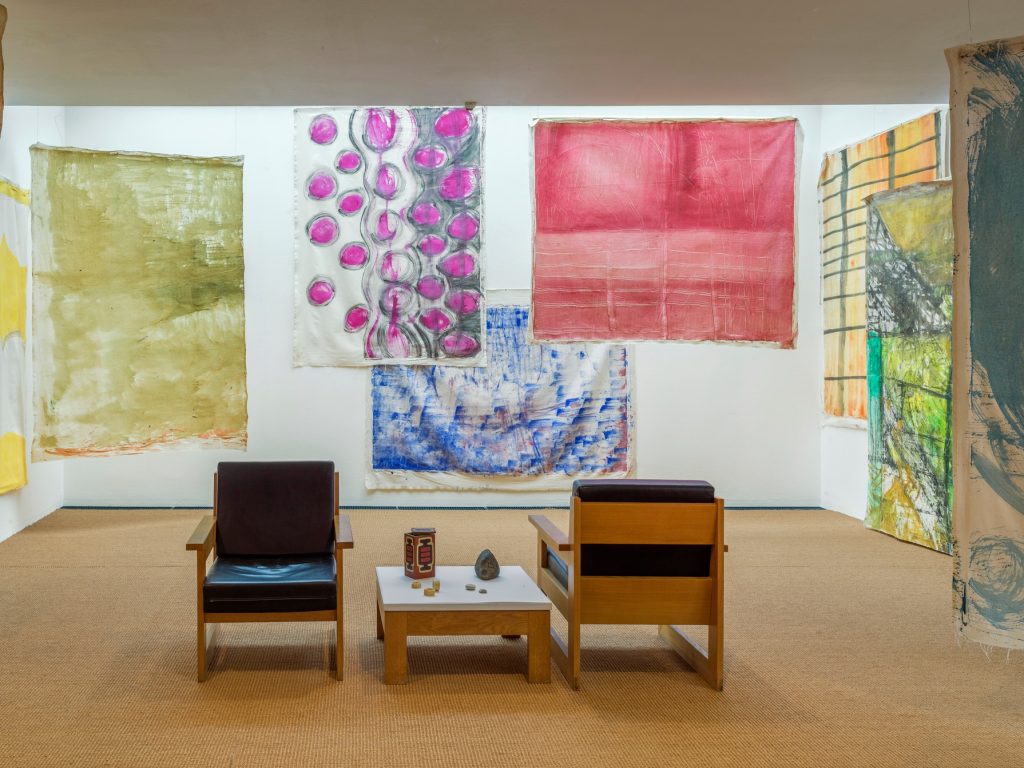
Vivian Suter, “Bonzo’s Dream,” 2020, Installation view, Brücke-Museum, Berlin, Foto: Roman März. Courtesy of the Artist und Gladstone Gallery, New York /Brüssel; House of Gaga; Karma International und Proyectos Ultravioleta.
The museum provides a warm setting for Suter’s work. Far from a big, echoey gallery, the institution backs into a forest, and features soft carpeting, skylights, and lounge chairs in a space that winds around in a loop. Suter’s works hang from the ceiling, drape onto the floor, and cover the walls. They move gently when viewers walk by.
Paw prints scuttle across at least one of her works and a silhouette of her dog, Bonzo, figures into another because “they are just there,” Suter said. And so are the trees, she points out. Another has dried leaves painted into it—it seems like they may have fallen onto a wet canvas and just stuck there.
The best work hangs outside, under a concrete overhang in the museum’s garden. There, several of Suter’s canvases float in the wind and the sun flickers through the forest against them.
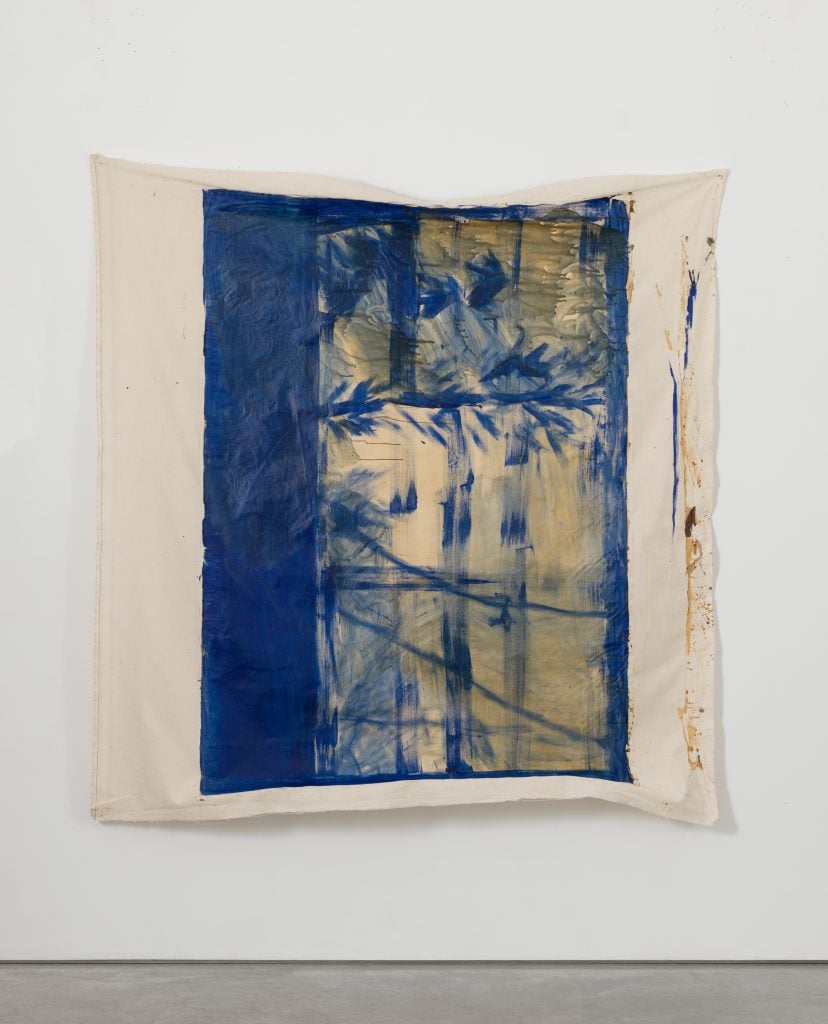
Vivian Suter Untitled (Undated). Copyright Vivian Suter. Courtesy of the Artist and Gladstone Gallery, New York und Brüssel; House of Gaga; Karma International; and Proyectos Ultravioleta.
I asked Suter how she felt about herself and her mother intercepting an artistic movement that was almost entirely male.
“It was about the art,” Suter said. “I always functioned like this. I did not put so much female emphasis on things. It is the result of the work that is interesting.”
Polish curator Adam Szymczyk, who is the curator of Wild’s current Karma International show, came across her work when he was recreating a 1981 group show that Suter was in, in 2011. Since then, he has worked with Suter and Wild frequently, including at Documenta 14. He describes their practices as different, yet complementary.
“Both work[ed] daily, taking their time to begin and the finish a piece in one day, sometimes let it rest some more days or months, and finish when the right moment or rain comes,” he explained over email.
While Suter worked very much in the world, Szymczyk said Wild “seemed to be turned to her many memories, including personal reminiscences and the visual repository of the 20th century: art, architecture, design, commercial photography—it is out of these vast visual fields she took fragments and rearranged them, reaching the fragile state of perfect estrangement of original familiar motifs, creating an entirely new universum, a language that is very much her own.”
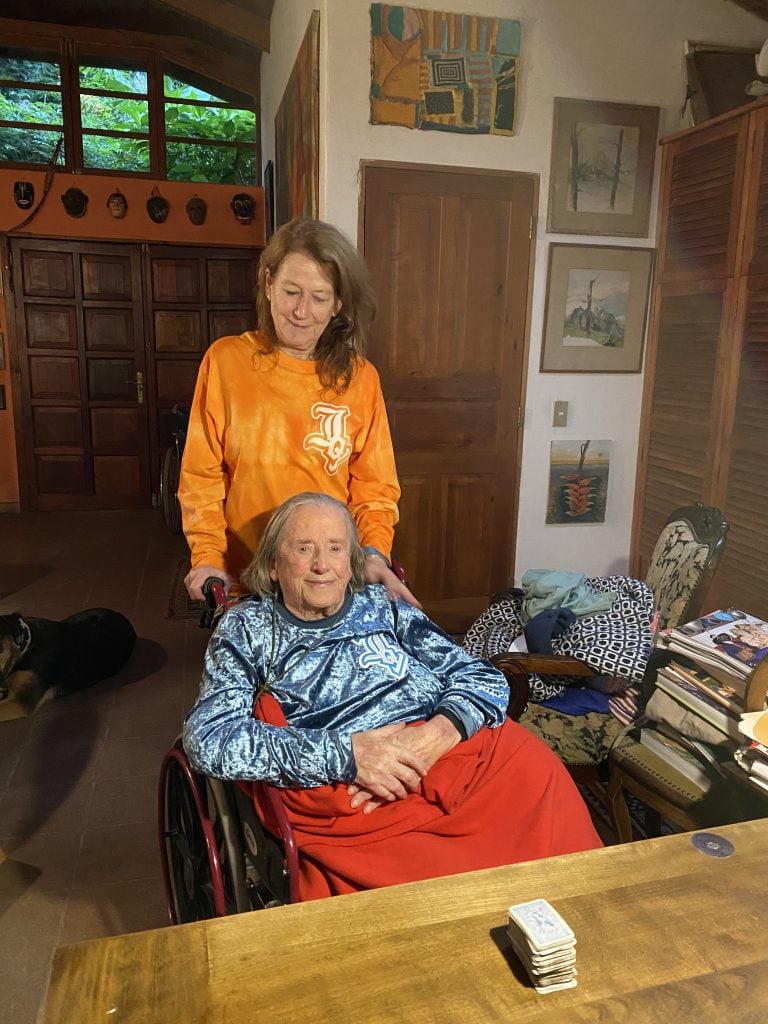
Vivian Suter and Elisabeth Wild at home. Courtesy the artist. Photo credits: © Flavio Karrer. Courtesy of the Artist and Karma International, Zurich; Gladstone Gallery, New York/Brussels; House of Gaga; and Proyectos Ultravioleta.
Their family story is one of seeking refuge. Wild was born to a Jewish father and Catholic mother in Vienna in 1922; when she was young, the family fled to Argentina to avoid the grips of rising Nazism in Europe. As a young woman, now married and with her young daughter Vivian, Wild traveled back to Europe to steer clear of the Argentinian dictatorship under Juan Perón.
Even as a young child, Suter was encouraged by her mother to make art. “I always saw her painting, and I painted with her, since I can remember. She called me BB—I used to say ‘BB paints and Mami also,’” Suter said.
They settled in Basel for the next decades, where Suter went to art school and started her career. Then, it was time to go again, Suter said. “I wanted to be freer, and get other inspiration. And nature is my big inspiration.”
In 1982, following a divorce, and prompted by a feeling of fatigue with the art world and city-dwelling, Suter made a trip to Central America. “I wanted to isolate and concentrate on my work more than on all these social events that you have to go to, and all the influences. I wanted to find my own path,” she said.
She never really returned, and she and her mother lived at the base of a trio of volcanos near Lake Atitlán in the Guatemalan Highlands. Ironically, they arrived when Guatemala was in a civil war, but they found refuge all the same on a former coffee plantation. They built their separate homes. Suter said that Wild was quite critical, so while she looked over her mother’s work, her mother never really came to her outdoor studio.
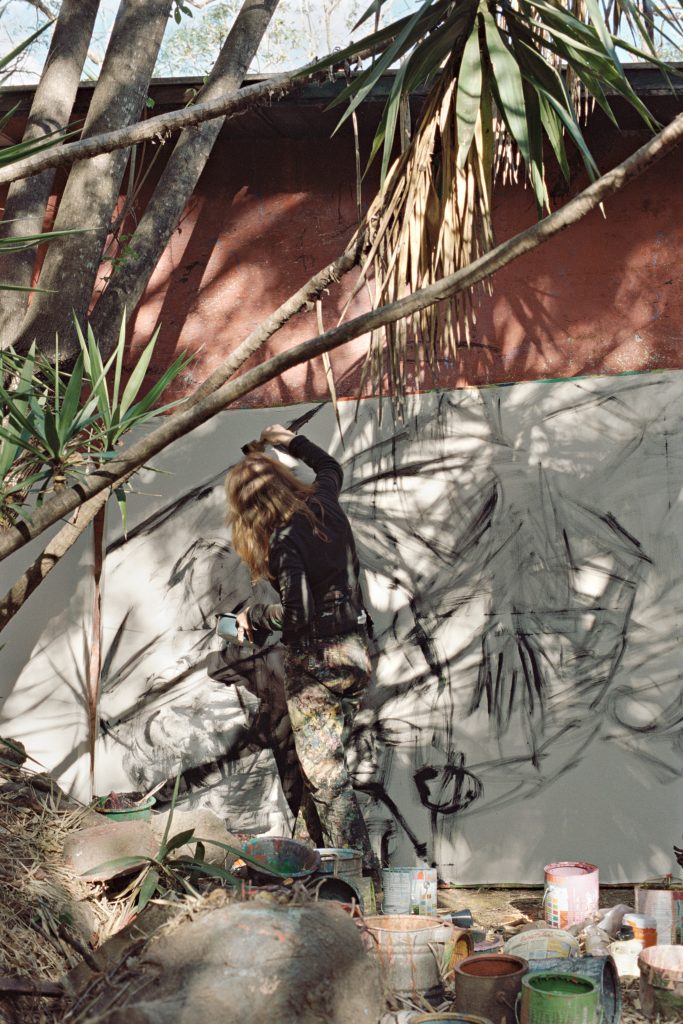
Vivian Suter, Studio view, Panajachel, Guatemala, 2018. Courtesy of the Artist und Gladstone Gallery, New York/Brüssel; House of Gaga; Karma International und Proyectos Ultravioleta. Foto: David Regen
The work does keep her busy. Suter is currently working on several major projects, including one at the Reina Sofia in Madrid that opens on November 5. Her next project, coming up in 2021, is a commission for London’s Stratford station. One of Wild’s last projects was to design a tube map for London’s ongoing project Art on the Underground. It will be released sometime next year.
Since her mother’s death, Suter has brought her ashes to her house so that they are with her all the time. Everything is left intact at her Wild’s home, but Suter is now using it to store some works that will be picked up for gallery and museum shows. She goes up and down the hill between their houses, as she always did.
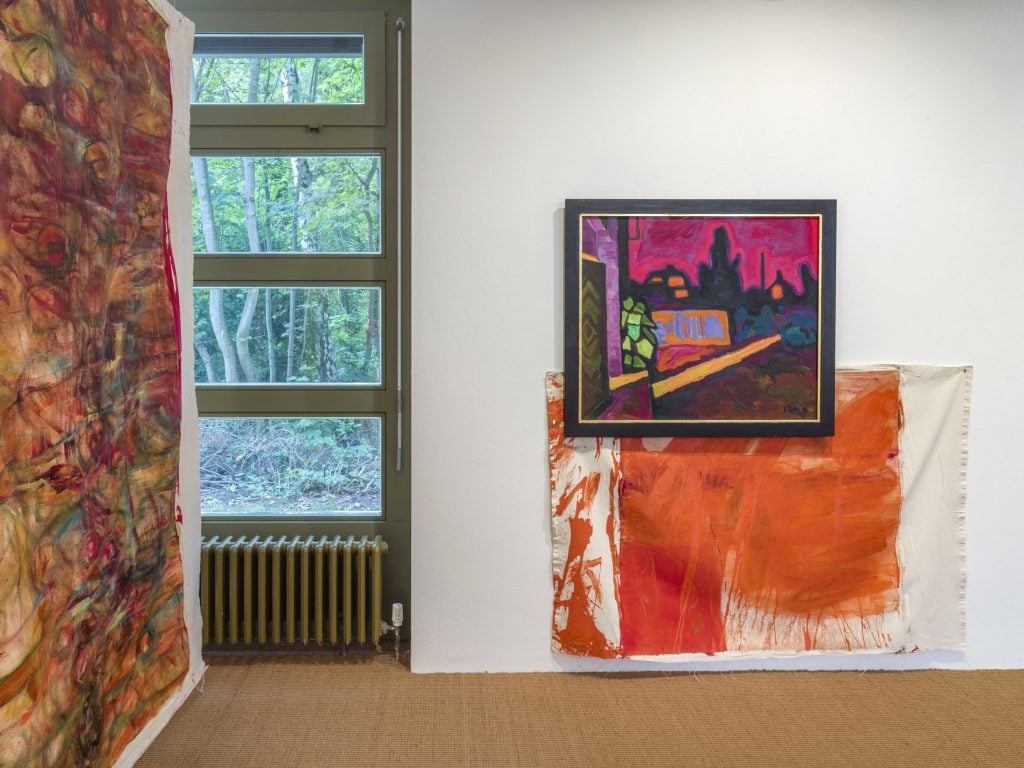
Vivian Suter, “Bonzo’s Dream,” 2020, Installation view, Brücke-Museum, Berlin, Foto: Roman März. Courtesy of the Artist und Gladstone Gallery, New York /Brüssel; House of Gaga; Karma International und Proyectos Ultravioleta.
Asked by a journalist for the Guardian in January if she would ever leave, Suter demurred. “Why would I?… My best friend is here. The question is what will happen when she goes.”
When I asked her how she felt now, she paused. She is keen to travel, she said, but wonders what it would be like to return.
“It will be more difficult to come back,” she said. “When I left, my mother was here, taking care of the dogs. When I leave, it will be difficult emotionally—that I haven’t experienced yet. I don’t know how I will continue, but I have lived here for over 30 years. The garden is so important in my life. I would not know where better to go.”
“Elisabeth Wild” is on view until October 24, 2020, at Karma International in Zürich.
“Vivian Suter: Bonzo’s Dream” is on view until Feburary 14, 2021, at the Bruecke Museum in Berlin.